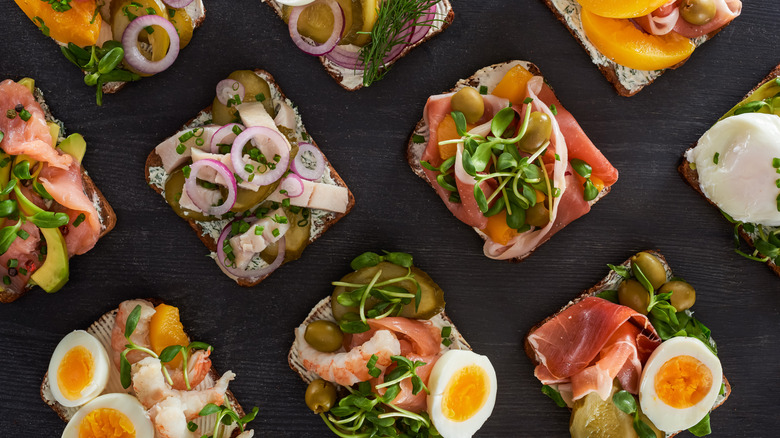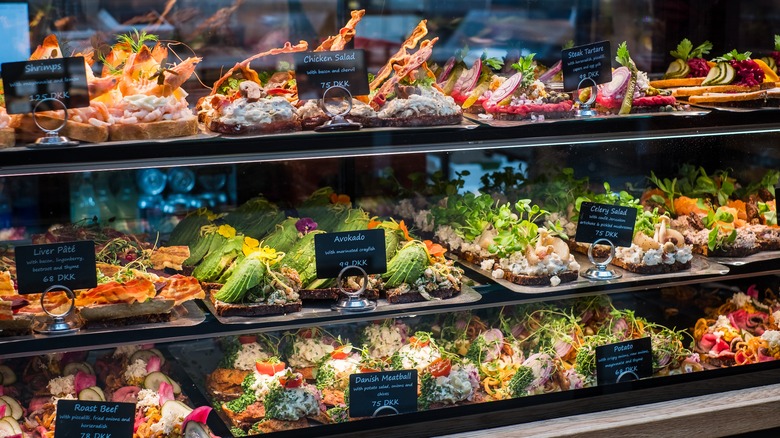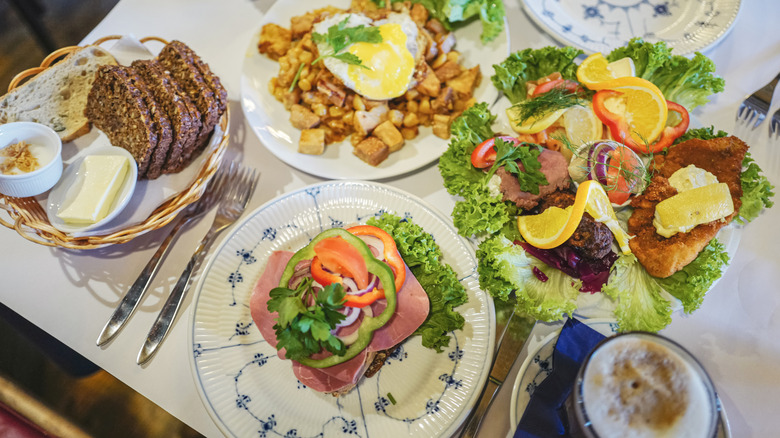The Origin Story Of Denmark's Iconic Open-Faced Sandwiches
Danish cuisine was almost completely overlooked by the world at large until the 21st century, when the New Nordic food manifesto captivated the hearts of the culinary world, spearheaded by the acclaimed Copenhagen restaurant Noma. Once the Danish restaurant started topping "best of" lists, all eyes fell on Denmark and the New Nordic culinary style. But the dishes served at Noma and depicted in the high-end restaurant's cookbook — dishes built on molecular gastronomy featuring moss and foam — are far removed from what the average Dane eats. If you want to understand real Danish cuisine, the traditional food that has been loved by generations, you need to try smørrebrød.
Smørrebrød is an umbrella term for open-faced sandwiches, which are a big deal in Scandinavia, evidenced by the Swedish saying "to slide in on a shrimp sandwich." But no country does the dish quite like Denmark. The name smørrebrød translates to "butter bread," a reference to the sandwich's typical base of a small slice of Danish rye bread smeared with butter. Aside from those two staple ingredients, however, smørrebrød are a blank canvas. There are countless combinations of toppings, with beef, fish, cheese, and eggs being particularly common. Presentation is as important as ingredients themselves, so smørrebrød are traditionally assembled with great attention to aesthetics. There's also a whole culture behind the practice of eating smørrebrød that dates back over two centuries.
The history of smørrebrød
Like so many delicious foods, smørrebrød began as a way to use leftovers. In the 1800s, wives of Nordic farmers would fix their husbands a midday meal by piling leftovers from the previous night's dinner onto a slice of bread. This was inspired by the medieval practice of eating food off of thick slices of bread called "trenchers," which essentially served as stand-ins for plates, but with the added perk of edibility (via Britannica). Traditionally, one would eat all the toppings, then eat the bread, at which point it would have soaked up the toppings' flavors.
By the end of the 19th century, more and more people were working in factories. Smørrebrød provided the perfect lunchbox meal and its prevalence in Danish life grew even greater. Then, smørrebrød went commercial. Arguably, the most influential force in the history of the dish was Restaurant Oskar Davidsen, which opened in Copenhagen in 1888. Owners Oskar and Petra Davidsen served over 170 types of smørrebrød, resulting in menus that reached up to 4 feet long.
The Davidsens' great-granddaughter, Ida, picked up their mantle in the 1970s. She dedicated herself to spreading the gospel of smørrebrød globally, visiting American restaurants to showcase the dish and even preparing smørrebrød to serve to passengers on commercial flights. Today, Restaurant Ida Davidsen in Copenhagen continues the family's legacy with a menu of over 250 types of smørrebrød.
The proper way to eat smørrebrød
Smørrebrød are made on either white bread or Danish-style seeded rye bread called rugbrød, each slice of which is only about the size of a playing card. As such, the sandwiches are quite small, so you're meant to eat more than one. A traditional smørrebrød lunch spread will feature many varieties, but they're supposed to be eaten in a very specific order. Breaking the etiquette of smørrebrød is a social faux pas, so to spare you any embarrassment before the Danes in your life, here's how to eat the open-faced sandwiches correctly.
Smørrebrød should be eaten in this order: fish, meat, then finally cheese. For the fish, it's customary to begin with herring. Pickled herring is arguably the most famous topping for smørrebrød, often paired with raw onion, capers, and dill. After herring, you can move on to shellfish. Similar to a shrimp salad toast Skagen, shrimp and egg smørrebrød are especially popular. Next come the meats. In this category, roast beef is king, traditionally served with onions, pickles, and a bit of horseradish. Potato smørrebrød, one of the few vegetarian varieties, are also eaten with the meat course. Last come the cheeses, with Danish blue being a common choice. One final note: Unlike the sandwiches you're probably used to, smørrebrød are eaten with a knife and fork to keep the toppings from sliding off.


